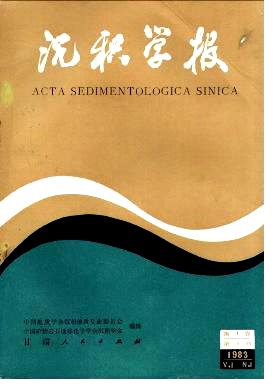THE COAL-BEARING FORMATION AND THE INCOALATION MODEL OF ALGAE-FLAT SWAMPS OF THE UPPER PERMIAN IN GUANGXI
- Received Date: 1982-06-17
- Publish Date: 1983-03-10
Abstract: The upper Permiau of Guangxi may be divided into two formations: Heshan and Changxing, including four types of coal-bearing formation of carbonate; residuum, algae-flat, mixed tide flat and winnowed platform edge sands. A. The residuum coal-bearing formation is of transgressive facies sequence—the residuum—the lacustrine—the bog—the tide flat, which consists of fcrro-beau- xite—cmpholite clay—coal bed—carbonaceous algae limestone. It appears at the bottom of the Heshan formation. The thickness of coal bed is labile. B. The algae-flat coal-bearing formation is of regressive facies sequence—open marine platform—the algae flat—the algae-flat swamp and the littoral marsh— the algae flat, which consists of biomicrite—Gymnocodium limestone—coal bed —Gymnocodium limestone.Most of them expose at the upper of the Heshan formation. The thickness of coal bed is thinner and more stable. C, The mixed tide flat coal-bearing formation is of regressive facies sequence —the mixed tide flat—the swamp—the mud flat, which consists of calcareous sandstone, mid stone and sparry iron, intercalating marlite (containing palaeophyte) —coal bed—clay bed. The coal bed is more unstable. D. The edge sands coal-bearing formation is of the tide flat — the winnowed platform edge sands—the tide flat—the algae- flat swamp—the tide flat,which consists of calcarenite—carbonaceous algae limestone— bed—mierite spongia algae limestone. The coal bed is most unstable. This paper will discuss the incoalation model of algae-flat swamp, taking the coal bed of the apper Heshan formation in central Guangxi as an example. 1. Palacotectonic seitings. tings. The formation was formed on the stable settle platform. The E-W strecture piling in this area played an upward well-fed part. The platform acquired more stable subsidence. 2 . Palaeogeographic conditions. Three parts of this area were surrounded by land. The Xeifeng land ( North ) and the Daminshan old land ( South ) had got aged. The uplifting Yunkai old land ( East ) transported its terrigenous elastics into the sea. But they were sustained by the bathyal basin at the margin of the old land. Therefore the water was shallow and clear on the platform. when the climate was warm and full of sunshine, organism was thriving and the carbonate platform was formed rapidly. The other part of the platform was open to the sea. The water came in and out freely. With difference of relief, the facies change occurre 3 . The effect of algae. The algae, especially the Gymnocodium were dominant in the roof and bottom of coal bed. Sometimes they formed the algae limestone. That the Gymnocodium always intergrew with some of algae colloid foraminifera and ostracod showed shallow water circumstance. It is somewhat difficult to sort the clastic of organism and it was intact individually,sometimes it could be distinte-grated or broken. Their edge angles and less abrasion showed a lower energy and intermittent turbulent environment. After the depth of the Gymnocodium, most of them accumulated in situ,and spread to laminate on the floor. It is called the algae-flat. Accompanying the platform uplift, the Gymnocodium played an important role in the shallowing upward sequence. When the algae-flat rose above the low tide, the soil in which plants grew occurred. 4 . Coal-forming substances. In the past people did not know the origin that coal bed cored on the limestone. When the present mangrove ( eg. Rhizophoraceae ) plants are observed in the intertidal zone, the view that peat could be formed by mangrove-like plants is put forward. It is imaginable that the plants of late palaeozoic era could live in saline or brackish water. Later we noticed that the fossils of normal swamp were found on the roof of coal bed as well. Therefore, in the in-coalation process, the coal-forming plants of coal bed of Heshan formation were mangrove-like plants in the earlier stage, and normal swamp plants in the middle and later stages and this was a
| Citation: | Chen Jianguo, Li Youliang. THE COAL-BEARING FORMATION AND THE INCOALATION MODEL OF ALGAE-FLAT SWAMPS OF THE UPPER PERMIAN IN GUANGXI[J]. Acta Sedimentologica Sinica, 1983, 1(1): 86-95. |






 DownLoad:
DownLoad: